Medieval Sweet and Sour Pork

This Medieval Sweet and Sour Pork is about to become your secret weapon for making people think you’re way more skilled in the kitchen than you actually are.
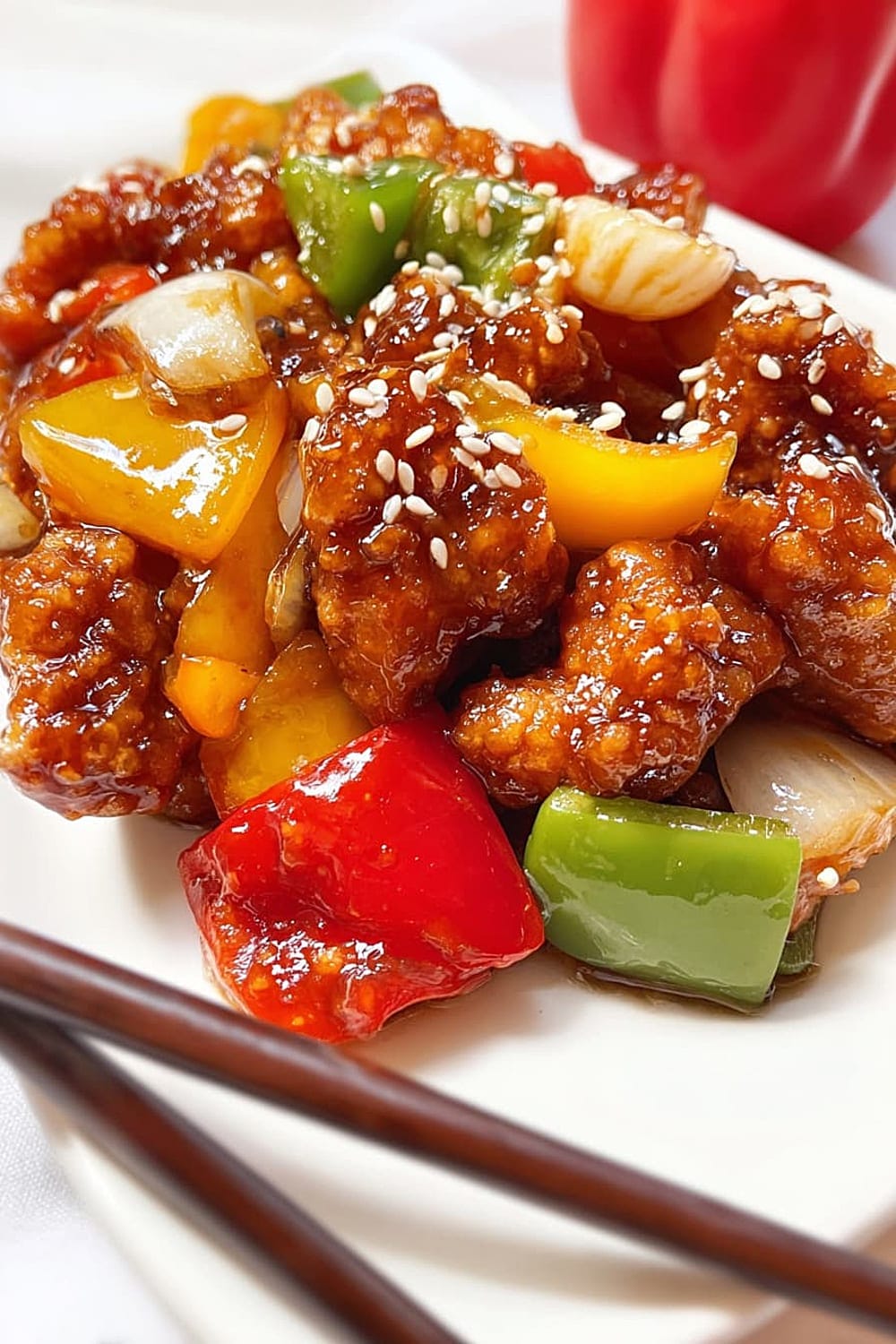
The double-frying technique creates pork so crispy it practically shatters when you bite into it, while that glossy sweet and sour sauce clings to every golden piece like edible armor.

Forget everything you know about soggy takeout versions – this homemade masterpiece delivers restaurant-quality results that’ll have your family asking if you secretly enrolled in culinary school.
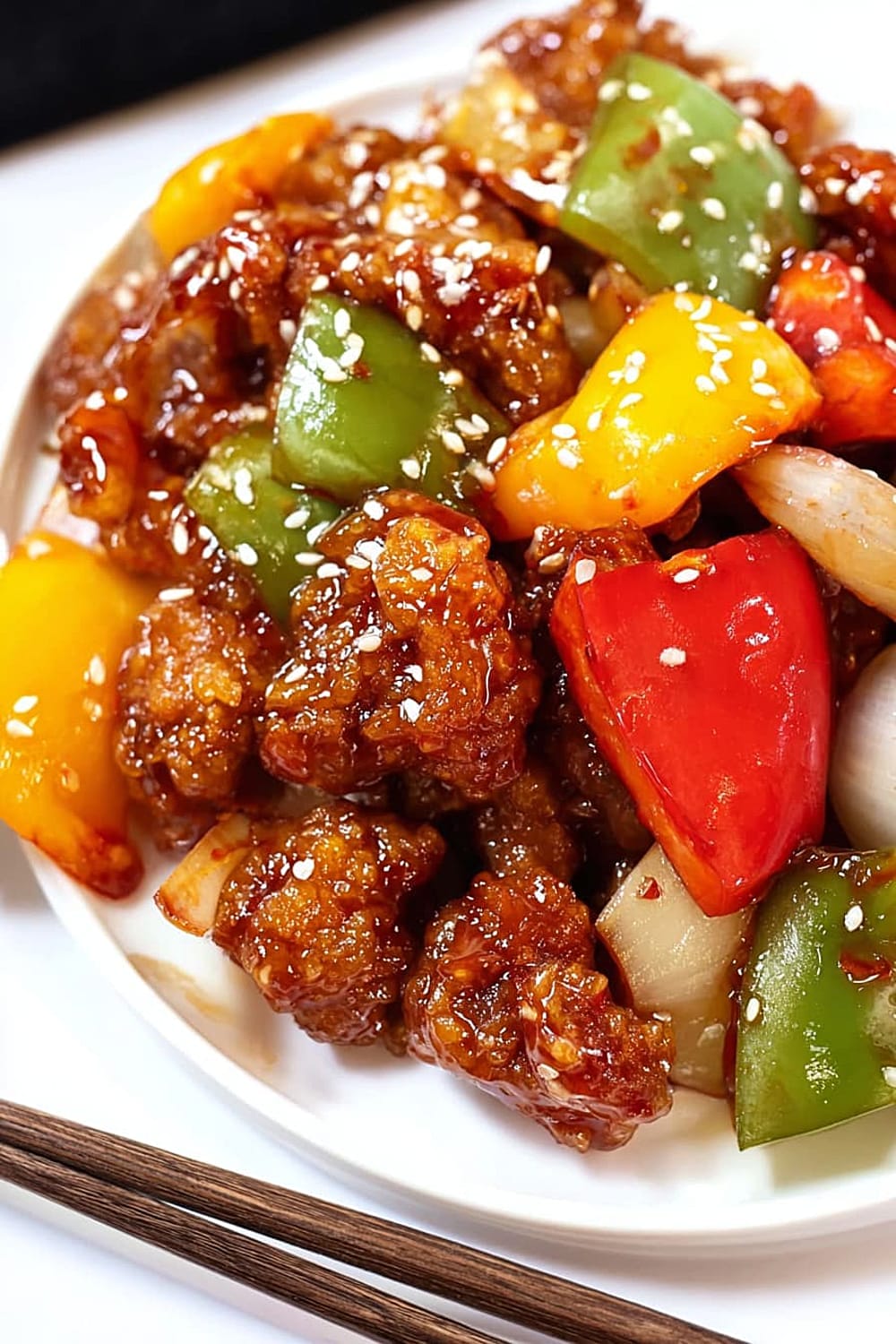
The marinade with baking soda is the game-changer here, tenderizing the pork to buttery perfection while the cornstarch batter creates an impossibly light, crispy shell.
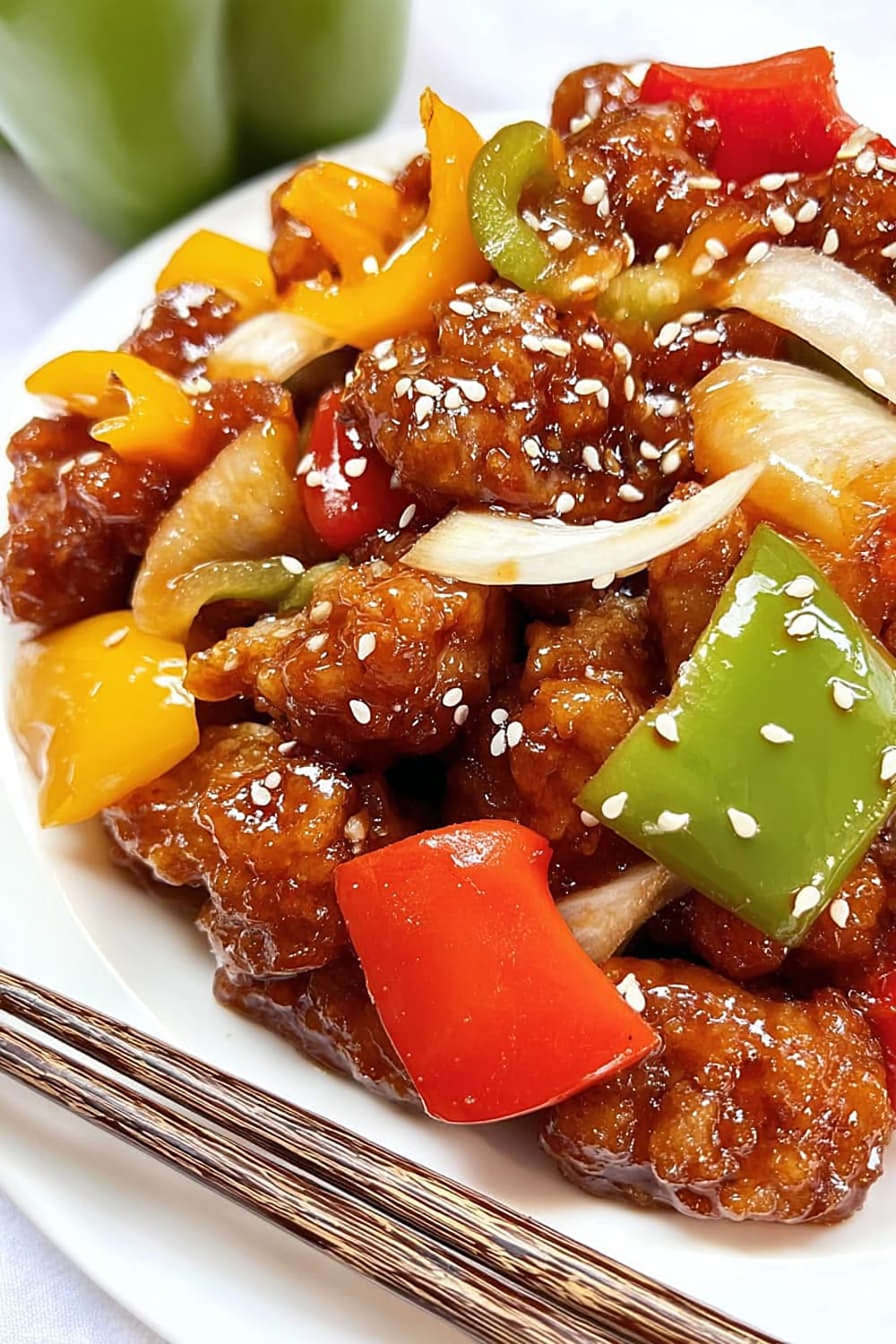
That first bite delivers the perfect balance of tangy vinegar, sweet pineapple, and savory umami that’ll make your taste buds do a little happy dance.
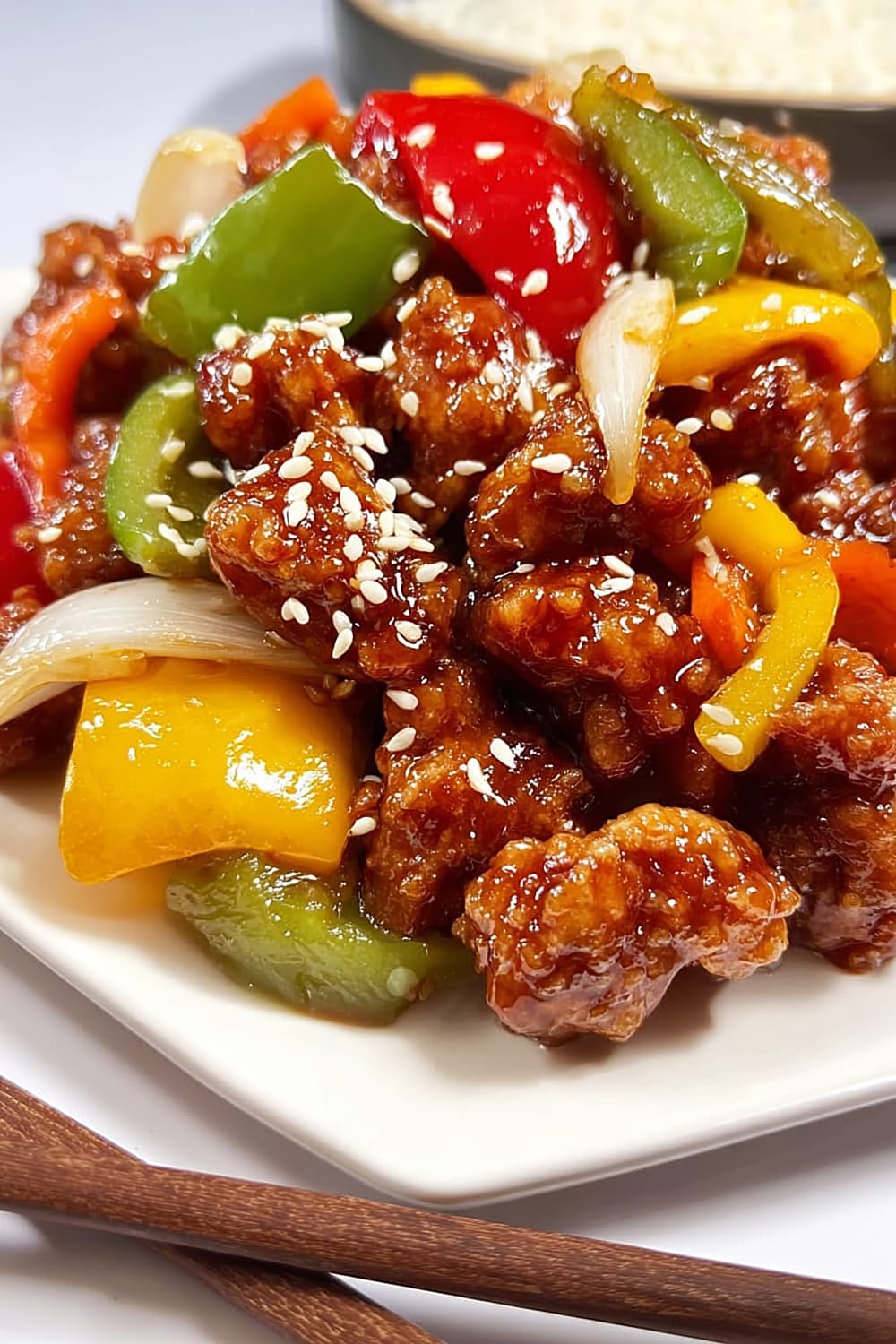
Plus, the whole thing comes together in under an hour, making it perfect for those nights when you want to impress without the stress-sweat of complicated cooking.

Ingredients
For the Pork
- 1 lb (450g) pork butt or pork shoulder, cut into bite-sized pieces
For the Vegetables
- 1 bell pepper, cut into triangles
- 1 small onion, quartered
- 150 g pineapple, cut into chunks
For the Marinade
- 1 tbsp soy sauce
- 1 tbsp Shaoxing wine
- 1 /2 tsp baking soda
- 1 /4 tsp white pepper
For the Batter
- 1 egg white
- 1 /2 cup cornstarch
- 2 tbsp flour
- 1 /3 cup water
For the Sweet and Sour Sauce
- 1 /4 cup white sugar
- 1 /4 cup ketchup
- 3 tbsp apple cider vinegar
- 1 tbsp soy sauce
- 1 /2 tsp chicken powder
- 1 /4 tsp salt
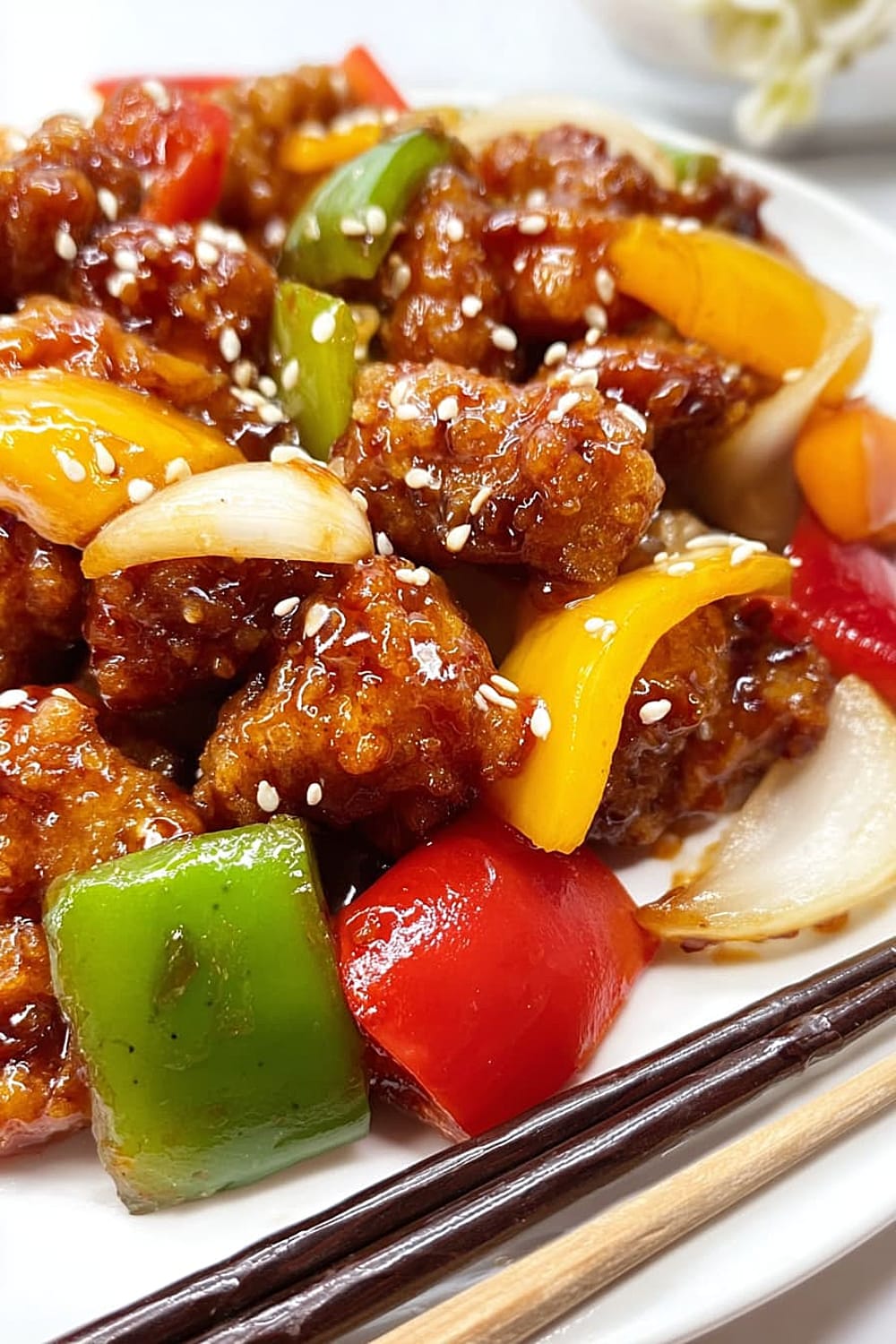
Instructions
Prepare the Pork
- 1 Mix the pork pieces with 1 tbsp soy sauce, 1 tbsp Shaoxing wine, 1/2 tsp baking soda, and 1/4 tsp white pepper in a mixing bowl. The baking soda is crucial here – it breaks down the proteins to create incredibly tender meat. Let this marinate for at least 15 minutes, though 30 minutes will give you even better results.
- 2 After marinating, add the egg white, 1/2 cup cornstarch, 2 tbsp flour, and 1/3 cup water to the pork. Mix until you achieve a wet, paint-like batter consistency. The batter should coat the pork completely but not be so thick it clumps. If it’s too thick, add water 1 tablespoon at a time until you reach the right consistency.
First Frying Round
- 3 Heat oil in a deep pan or wok to 330-340°F (165-170°C) – use an instant-read thermometer for accuracy. Fry the battered pork in batches for 7-8 minutes, ensuring pieces don’t overcrowd the pan. The pork should be fully cooked through and lightly golden. Remove and let the fried pork rest on a wire rack for at least 10 minutes before the second frying.
Double Fry for Maximum Crispiness
- 4 Turn the heat to high and bring the oil temperature to 375°F (190°C). Double fry the pork for 30-60 seconds until golden brown and incredibly crispy. This second frying is what creates that signature shatteringly crisp exterior. Set aside to cool on a wire rack – resist the urge to pile them on paper towels, which will make them soggy.
Prepare Vegetables and Sauce
- 5 In an empty wok or large pan over medium-high heat, stir-fry the quartered onions, bell pepper triangles, and pineapple chunks until soft and tender, about 3-5 minutes. The vegetables should still have some bite to them. Set aside on a plate.
- 6 Prepare the sweet and sour sauce by whisking together 1/4 cup white sugar, 1/4 cup ketchup, 3 tbsp apple cider vinegar, 1 tbsp soy sauce, 1/2 tsp chicken powder, and 1/4 tsp salt until completely smooth. Pour this mixture into the same pan and bring to a low boil for 2-3 minutes until just thickened and glossy.
Final Assembly
- 7 Add the stir-fried vegetables and crispy fried pork to the sauce. Quickly toss for 15-30 seconds until all pieces are fully coated in the glossy sauce. Work fast here – you want everything hot and the pork to maintain its crispiness. Serve immediately and top with sesame seeds for extra flavor and visual appeal.
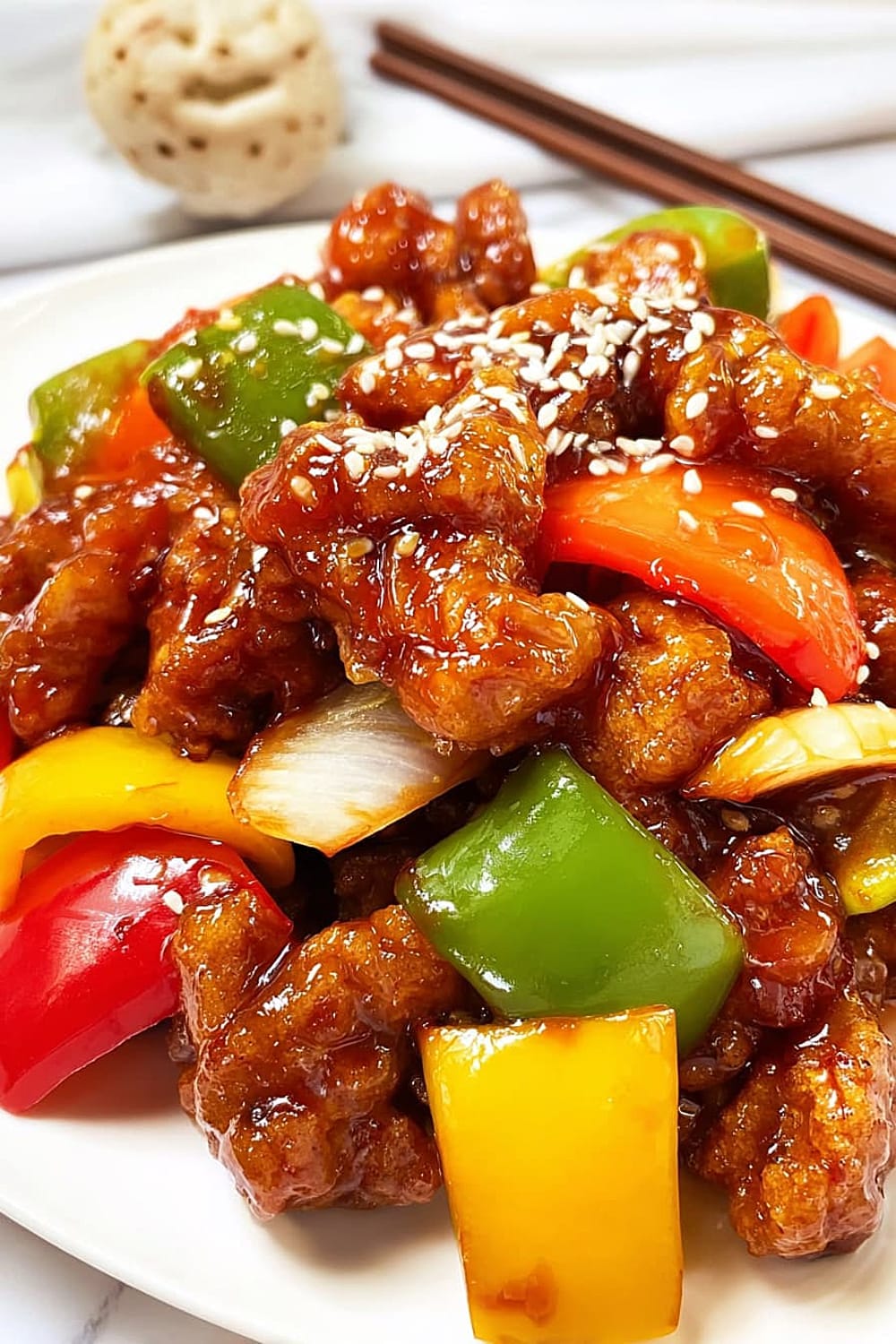
Recommended Equipment and Kitchen Tools
Recommended Tools (for best results):
- Instant-read thermometer – Essential for maintaining proper oil temperatures during frying. The difference between 330°F and 375°F is what makes or breaks this recipe’s texture
- Wire rack – Keeps fried pork crispy by allowing air circulation instead of steaming on paper towels
- Large wok or deep pan – Provides ample space for frying without overcrowding, ensuring even cooking
- Fine-mesh strainer – Perfect for removing any batter bits from the oil between batches
Helpful Upgrades:
- Digital kitchen scale – Measuring ingredients by weight ensures consistent results, especially for the batter consistency
- Cast iron wok – Retains heat beautifully for consistent frying temperatures and excellent stir-frying
- Silicone-tipped tongs – Won’t scratch your cookware and provide excellent grip for turning pork pieces safely
Nice-to-Have Options:
- Splatter screen – Keeps your stovetop clean during the frying process without affecting oil temperature
- Small whisk – Makes combining the sweet and sour sauce ingredients effortless and lump-free
- Prep bowls – Having everything measured and ready makes the final assembly much smoother

Recipe Variations and Dietary Modifications
Gluten-Free Adaptation:
- Replace the 2 tbsp flour in the batter with 2 tbsp additional cornstarch for a completely gluten-free version
- Substitute tamari for soy sauce in both the marinade and sauce
- The texture will be slightly more delicate, but equally crispy
- Consider adding 1/4 tsp xanthan gum to help bind the batter if needed
Protein Variations:
- Chicken thighs work beautifully with the same marinade and cooking times
- Firm tofu (pressed and cubed) creates an excellent vegetarian version – reduce first frying time to 5-6 minutes
- Shrimp requires only 3-4 minutes for the first frying and 15-20 seconds for the second
Flavor Variations:
- Spicy version: Add 1-2 tsp chili garlic sauce to the sweet and sour sauce
- Tropical twist: Include mango chunks alongside the pineapple for extra sweetness
- Asian fusion: Add 1 tbsp rice vinegar and 1 tsp sesame oil to the sauce for deeper complexity
- Seasonal adaptation: Substitute bell peppers with snow peas or baby corn for different textures
Vegetable Combinations:
- Classic combo: Bell peppers, onions, and pineapple as written
- Colorful mix: Use red, yellow, and green bell peppers for visual appeal
- Asian vegetables: Try bok choy, water chestnuts, and bamboo shoots
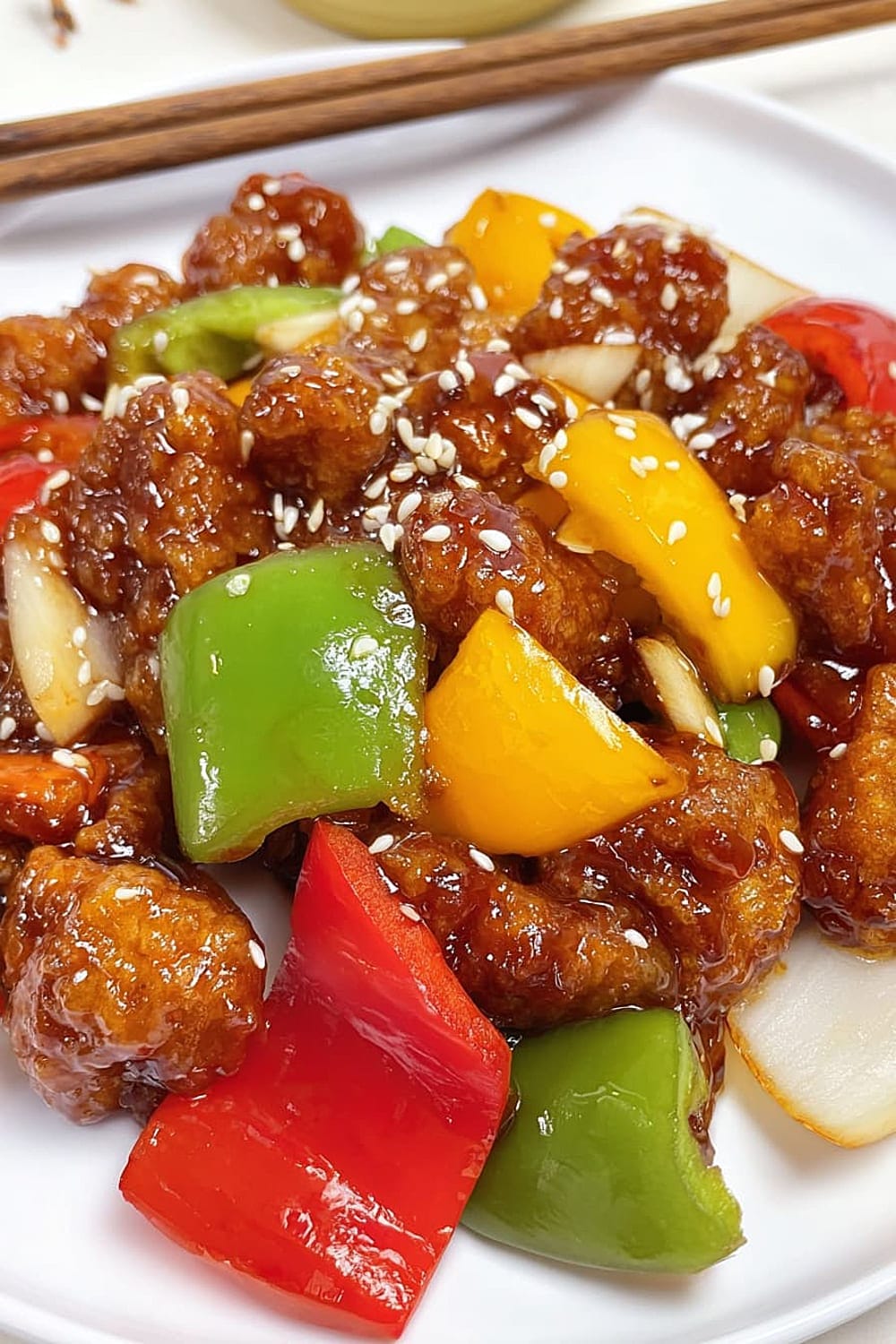
Nutritional Information and Health Benefits
Key Nutritional Highlights:
This Medieval Sweet and Sour Pork provides approximately 380-420 calories per serving when divided into 4 portions. The dish delivers 25-28g of high-quality protein from the pork shoulder, which contains all essential amino acids needed for muscle maintenance and repair. The cornstarch batter adds 15-18g of carbohydrates, while the sweet and sour sauce contributes additional 12-15g of carbs primarily from natural sugars.
Health Benefits of Main Ingredients:
Pork shoulder provides excellent amounts of thiamine (Vitamin B1), essential for energy metabolism and nervous system function. It’s also rich in selenium, a powerful antioxidant that supports immune function. The pineapple contains bromelain, an enzyme that aids digestion and has anti-inflammatory properties, plus vitamin C for immune support. Bell peppers are loaded with vitamin C – actually containing more per serving than citrus fruits – and vitamin A for eye health. The apple cider vinegar in the sauce may help with blood sugar regulation and provides beneficial acetic acid.
Dietary Considerations:
This recipe contains gluten (from flour), soy (from soy sauce), and eggs (from egg white). The dish is naturally dairy-free and nut-free. Each serving provides approximately 8-10g of fat, primarily from the frying oil and natural pork fat. The sodium content is moderate at about 680-720mg per serving, mainly from the soy sauce and ketchup components.

Smart Swaps and Ingredient Substitutions
Common Substitutions:
- Shaoxing wine → Dry sherry or mirin (same 1:1 ratio)
- Chicken powder → Chicken bouillon powder or mushroom powder for umami depth
- Pork shoulder → Pork tenderloin (reduce first frying time to 5-6 minutes)
- Fresh pineapple → Canned pineapple chunks (drain thoroughly first)
Budget-Friendly Swaps:
- Pork shoulder → Chicken thighs (often more affordable and equally flavorful)
- Fresh bell peppers → Frozen bell pepper strips (thaw and pat dry before cooking)
- Apple cider vinegar → White vinegar (use 2 tbsp instead of 3 tbsp as it’s stronger)
Pantry Emergency Substitutions:
- Cornstarch → Potato starch or all-purpose flour (texture will be slightly different)
- Ketchup → Tomato paste (2 tbsp) + 2 tbsp sugar + 1 tbsp vinegar
- Egg white → 2 tbsp aquafaba (chickpea liquid) for vegan option
Pro Tips for Substitutions:
- When using frozen vegetables, increase cooking time by 1-2 minutes to evaporate excess moisture
- Store Shaoxing wine in the refrigerator after opening – it keeps for 6-8 months
- Chicken powder can be found in Asian grocery stores and adds authentic flavor depth

Make It Diabetes-Friendly
Sugar Substitutions:
- Replace 1/4 cup white sugar with 2-3 tbsp erythritol or monk fruit sweetener
- Stevia option: Use 1 tsp liquid stevia instead of granulated sugar
- Natural alternative: 2 tbsp sugar-free maple syrup works well with the flavor profile
- Carb reduction: These swaps reduce carbs by approximately 12-15g per serving
Flour & Carb Modifications:
- Replace 2 tbsp flour with almond flour (same amount) to reduce carbs by 4-5g
- Cornstarch reduction: Use 1/3 cup instead of 1/2 cup and add 2 tbsp almond flour
- Coating alternative: Crushed pork rinds mixed with cornstarch creates ultra-low-carb coating
Portion & Timing Tips:
- Recommended serving size: 3/4 cup with 1 cup steamed broccoli or cauliflower rice
- Estimated carbs per modified serving: 8-12g (down from 18-20g original)
- Pairing strategy: Serve with stir-fried vegetables and brown rice (1/3 cup cooked) for balanced meal
- Blood sugar management: The protein and fat content help slow carb absorption
Total Carb Reduction: 40-50% reduction when using all suggested modifications

Perfect Pairing Suggestions
Beverage Pairings:
Riesling or Gewürztraminer complement the sweet and sour flavors beautifully, while their acidity cuts through the richness of the fried pork. For beer lovers, a crisp lager or wheat beer provides refreshing contrast. Jasmine tea or oolong tea offer traditional Asian pairings that cleanse the palate between bites. Sparkling water with lime or ginger ale provide non-alcoholic options that enhance the dish’s bright flavors.
Side Dish Recommendations:
Steamed jasmine rice is the classic choice, absorbing the sweet and sour sauce perfectly. Coconut rice adds tropical richness that complements the pineapple. Stir-fried bok choy with garlic provides a fresh, slightly bitter contrast to the sweet sauce. Asian cucumber salad with rice vinegar offers cooling crunch that balances the rich, fried pork. Vegetable spring rolls make excellent appetizers that share similar flavor profiles.
Complete Meal Ideas:
Start with hot and sour soup to prepare the palate, serve the sweet and sour pork as the main course with vegetable fried rice, and finish with mango sticky rice for dessert. For family-style dining, pair with kung pao chicken and ma po tofu for variety. Steamed dumplings make excellent appetizers that complement the Chinese-inspired flavors.
Occasion Suggestions:
Perfect for weekend family dinners when you have time for the double-frying technique. Excellent for casual entertaining since it can be partially prepped ahead. Chinese New Year celebrations call for this type of festive, colorful dish. Potluck dinners showcase your cooking skills while being crowd-friendly.

Pro Tips and Troubleshooting
Professional Frying Tips:
The oil temperature is absolutely critical – too low and your pork will be greasy, too high and it burns before cooking through. Batch frying prevents temperature drops that create soggy coating. Rest time between first and second frying allows moisture to redistribute, ensuring the second fry creates maximum crispiness. Wire rack cooling maintains crispiness by preventing steam buildup.
Common Mistakes and Solutions:
Soggy coating usually means oil temperature was too low or pieces were overcrowded. Tough pork indicates insufficient marinating time – the baking soda needs at least 15 minutes to work its magic. Sauce too thin means it didn’t reduce enough; simmer an extra 1-2 minutes until glossy. Vegetables overcooked happens when they’re added too early; they should retain some crunch for textural contrast.
Storage and Reheating:
Store leftover pork separately from sauce and vegetables in the refrigerator for up to 3 days. Reheat pork in a 400°F oven for 5-7 minutes to restore crispiness – never use the microwave. Sauce and vegetables can be reheated in a pan with a splash of water. Freezing isn’t recommended as it compromises the crispy texture.
Make-Ahead Strategies:
Marinate pork up to 24 hours in advance for even better flavor. Prep vegetables and mix sauce the morning of cooking. First frying can be done 2-3 hours ahead, then double-fry just before serving. Scale up easily by doubling ingredients but fry in smaller batches to maintain oil temperature.
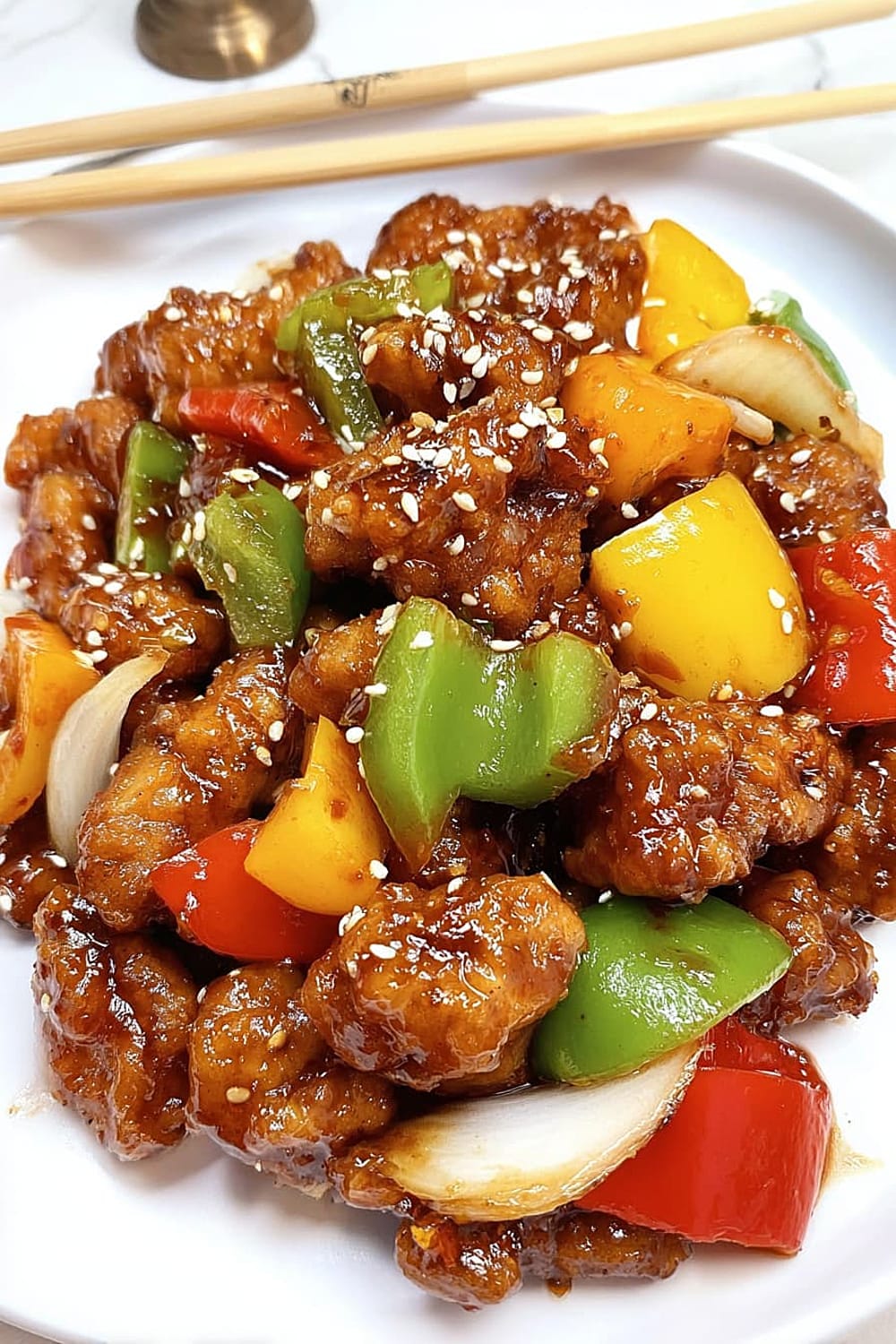
This Medieval Sweet and Sour Pork proves that restaurant-quality results are absolutely achievable in your home kitchen. The combination of proper technique, quality ingredients, and a little patience creates a dish that’s guaranteed to become a family favorite and dinner party showstopper.